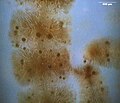A rheophile is an animal that prefers to live in fast-moving water. Many aquatic insects living in riffles require current to survive. Epeorus sylvicola...
4 KB (354 words) - 13:46, 1 March 2022
International scale of river difficulty - for classification of rapids Rheophile - organisms that live in fast-flowing water Riffle - A fast-moving portion...
8 KB (699 words) - 09:59, 31 May 2024
The Wertheimers would receive a 70 percent share of the company, and Rheophile Bader, founder of the Paris department store Galeries Lafayette, would...
33 KB (4,203 words) - 07:50, 15 September 2024
northwestern Madagascar. Like other members of the lamena group, it is a rheophile (although less so than Oxylapia polli). This relatively elongate Paretroplus...
2 KB (121 words) - 22:46, 16 November 2021
that "learns" about river ecosystems Flood pulse concept Lake ecosystem Rheophile Riparian zone River continuum concept River drainage system RIVPACS The...
84 KB (9,930 words) - 06:34, 19 May 2024
This species can reach a length of 14 cm (5.5 in). This species is a rheophile and has an elongated body shape and underdeveloped swimbladder. The species...
1 KB (70 words) - 05:57, 16 April 2024
Spongillidae †Ephydatia Ephydatia gutenbergiana Müller et al. 1982 A possibly rheophile species sponge, it grew dominant under favorable conditions and gradually...
114 KB (5,957 words) - 12:37, 2 November 2024
with various flow velocities, averaging 32 cm/s, which qualifies it as a rheophile. However, it is also found in slower-flowing and stagnant waters. The...
40 KB (4,323 words) - 15:09, 14 November 2024
macrophytes, especially among different species. Representatives are often rheophiles or rheobionts and live in waters with a wide range of current velocities...
31 KB (3,188 words) - 02:28, 3 November 2024
to Peru where it is found in the upper Amazon basin. P. microps is a rheophile, which means it likes fast-moving water. Pterosturisoma microps reaches...
2 KB (199 words) - 16:09, 28 January 2024
and invasive species. Like other members of the lamena group, it is a rheophile (although less so than Oxylapia polli), and typically found in river sections...
3 KB (283 words) - 21:40, 15 November 2021
Archolaemus (Ostariophysi, Gymnotiformes): undetected diversity in a clade of rheophiles". Zoological Journal of the Linnean Society. 165 (3): 670–699. doi:10...
2 KB (157 words) - 22:05, 15 April 2024
Archolaemus (Ostariophysi, Gymnotiformes): undetected diversity in a clade of rheophiles". Zoological Journal of the Linnean Society. 165 (3): 670–699. doi:10...
2 KB (142 words) - 22:04, 15 April 2024
Archolaemus (Ostariophysi, Gymnotiformes): undetected diversity in a clade of rheophiles". Zoological Journal of the Linnean Society. 165 (3): 670–699. doi:10...
1 KB (83 words) - 22:05, 15 April 2024
Archolaemus (Ostariophysi, Gymnotiformes): undetected diversity in a clade of rheophiles". Zoological Journal of the Linnean Society. 165 (3): 670–699. doi:10...
2 KB (163 words) - 22:04, 15 April 2024
Archolaemus (Ostariophysi, Gymnotiformes): undetected diversity in a clade of rheophiles". Zoological Journal of the Linnean Society. 165 (3): 670–699. doi:10...
5 KB (557 words) - 00:58, 15 August 2024
is not known in the Afrotropical region. This freshwater limpet is a rheophile, which lives in oxygen-rich fast-running waters and also in karst springs...
6 KB (646 words) - 14:34, 28 October 2024
globose shell is adapted for inhabiting high-velocity lotic environments (rheophile animal), because it allows for a large, muscular foot that can suction...
9 KB (1,059 words) - 03:12, 4 June 2024
Archolaemus (Ostariophysi, Gymnotiformes): undetected diversity in a clade of rheophiles". Zoological Journal of the Linnean Society. 165 (3): 670–699. doi:10...
3 KB (210 words) - 11:54, 14 August 2024







